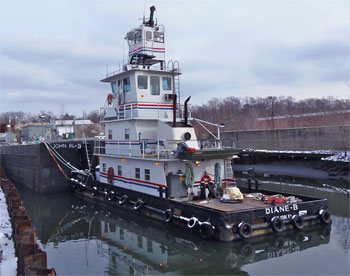Sunrise on a cold February morning found the towboat and barge surrounded by so little water that they hardly seemed afloat.
The barge was light: 10,000 barrels of heating oil had been transferred into the steel tanks of the Sprague Energy terminal before daybreak. The terminal in this industrial zone of Mount Vernon, N.Y., was quiet now, the only sounds coming from Department of Public Works trucks leaving to salt the roadways.
Capt. Tom Gallagher, the master of American Petroleum & Transport’s pushboat Diane B and its barge John Blanche, was on watch. A hawsepiper, he comes from a family of fishermen and shipyard workers in Point Pleasant, N.J. But 30 years ago, a job as deck hand on the Eklof tanker Aquarius called him to a new line of work. These days his specialty is something he calls “creek work.”
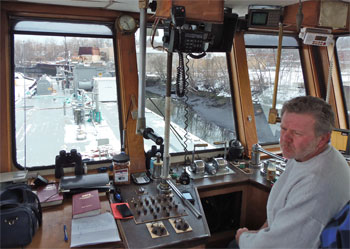 |
|
Capt. Tom Gallagher at the wheel of Diane B. |
The Sprague Energy terminal is at the head of Eastchester Creek, one of a half dozen narrow, convoluted, rock-strewn creeks in the New York City area that carry commerce. Creek work is not for everybody, according to Gallagher. “Local knowledge is essential on the creeks. You have to work with the tides. You can only get a loaded barge to the terminal at top of high tide.”
Diane B and John Blanche have a combined overall length of 250 feet. The barge has a beam of 34 feet and a draft of 9.9 feet loaded.
“You play the winds and watch blow-out tides,” he said.
Even at high tide, there are obstacles to avoid. Besides silt in the creeks, there are rocks. “Tie up at the wrong place in the terminal and the barge could break its back on the rocks,” Gallagher said. Other unseen obstacles in Eastchester Creek can include submerged pilings, tires, shopping carts, collapsed pieces of bulkhead, sunken barges, and metal that tumbled off the scrap barges that also work on the creek.
Crewmen on Diane B talked about the 1951 Chevy that seemed to creep down the mountain of cars once waiting to be scrapped at the salvage yard just north of the Boston Post Bridge near the border between the Bronx and Westchester County. “Each time we passed, the Chevy seemed closer to the water. Then one day it was gone,” said Phil Porteus, mate of Diane B. Hidden obstacles like the car could mean costly down time and repairs for the boat. A new propeller could run $10,000.
The bridges add another dimension to the challenge. To get the home heating oil to the Sprague Energy terminal, which is located about three miles up Eastchester Creek, Gallagher needs to negotiate four bascule bridges, two of which are over a century old. Gallagher needs to call the bridge operators with his projected arrival time, as coordinated with a favorable tide. But getting the bridges to open is never a given. In winter, road salt can corrode the wires and one or more of the spans might not lift. In summer, heat expansion can have the same effect. If the tow is caught upstream of a stuck bridge, the vessel is trapped there, and effectively out of commission.
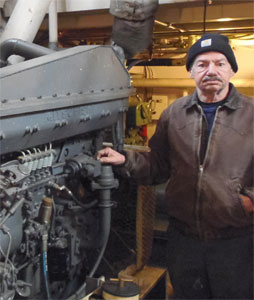 |
|
Engineer Frank Colalillo with the port Mitsubishi engine. |
Steve Bragoli, chief executive of American Petroleum & Transport, had a vessel trapped for two and half days when a bridge over Eastchester Creek stuck a few years back. In an attempt to recoup the value of the lost time, Bragoli sued the City of New York, lost and has appealed. “This caused us to lose a couple of jobs and the terminals ran low of diesel,” he said.
If this is starting to sound like more trouble than it’s worth, consider this: Each time Diane B gets John Blanche up to the Sprague terminal, it replaces more than three dozen trailer tankers that would otherwise clog highways and bridges. Some weeks, the unit can move a load of oil a day from KMI Carteret to Sprague, or over 200 trailers’ worth a week.
American Petroleum & Transport is a small company that got involved in creek work in 2005 when it purchased two tankers, Scotty Sky and Patrick Sky. These single-hull boats will be obsolete in 2015 because of the Oil Pollution Act of 1990. Although the tankers are currently in compliance and deliver to other terminals on other creeks, Sprague already prohibits the two tankers from delivering the oil.
“Small terminals on the creeks create jobs and reduce truck traffic,” explained Bragoli.
Larger companies like Reinauer and Eklof used to go into the creeks until they upgraded to double-hull barges and twin-screw boats, and then modified their business plan and gave up the creek work, according to Bragoli. But smaller operators like American Petroleum & Transport remain to fill an essential niche in the region’s fuel supply chain.
At the Sprague terminal there is no room to turn the unit. To exit, the crew of Diane B awaits sufficient water, undoes the wires connecting the towboat to the stern of John Blanche, eases alongside, and makes up to the barge, so that it exits the creek stern first.
The double-hull barge John Blanche was built in Louisiana in 2010 and is fully compliant with current laws and regulations. Diane B, built in 1980 in Louisiana, was first called Irene Frazier and operated for Kirby Corp. Given the recent acquisition by Kirby of many tugboats and barges operating in New York harbor, Diane B is unique in being an ex-Kirby boat. At 60 feet in length overall with a beam of 22 feet, Diane B is well suited for creek work, drawing less than eight feet.
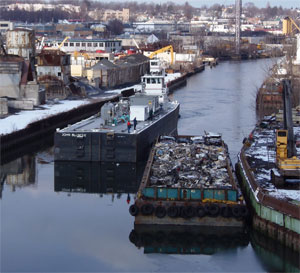 |
|
Diane B and John Blanche have to negotiate some tight spots. Here they squeeze past a scrap scow on Eastchester Creek (also known as the Hutchinson River) before emerging into more open water, bottom left. |
A drawback of that size, however, is that the five-person crew lives in close quarters. “We’re a week-on/week-off boat,” said Porteus. Although certified as mate, he functions as tankerman person-in-charge. He estimates he spends about 20 percent of his time keeping up on paperwork — nine different forms attesting to inspections, security, safety and taxes. At least two of these are federal forms to the U.S. Coast Guard and the U.S. Army Corps of Engineers. The Army Corps of Engineers Operations Report contributes information vital to the Corps’ decision-making about dredging operations, without which creek commerce would ultimately cease.
The critical job qualification for working on Eastchester Creek is local knowledge, enough familiarity with the creek to avoid damage to the equipment and the environment. The task of breaking in new talent falls on mariners like Gallagher, who tells stories about trying to train experienced harbor and coastwise captains in the intricacies of the creeks. About one such trainee, Gallagher said, “He rode along a number of times until he said he felt comfortable enough. I left him at the controls and settled back. But on a turn just before a bridge, he turned pale and started to sweat. I thought he was having a heart attack. He just froze up. I had to take over.”
Oil is not the only commodity moving up Eastchester Creek. According to the February 2012 U.S. Army Corps of Engineers Fact Sheet, Eastchester Creek is used to transport 739,000 tons of cargo annually, with 39 steel storage tanks able to accommodate nearly 230,000 barrels of petroleum. Several scrap metal yards and asphalt and concrete facilities operate near Sprague.
There are fewer businesses on the creek today than when Gallagher first started there, but the equipment is larger. “It was like a train back then,” he said, “a whole line of tugs with the barges and scows, with whoever went farther up going first.”
But even with fewer boats, operating in the creeks “can be a contact sport,” said Porteus.
Slow and fendered contact is sometimes the only way to negotiate turns where barges and scows might be docked. “Sometimes you need to shift other companies’ docked scows to get through,” Porteus said.
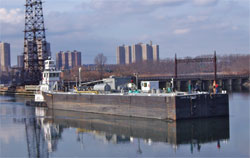 |
|
After making their way through a railroad bridge, the tug and barge set up for the Pelham Parkway Bridge in the Bronx on the northeast edge of New York City. |
Mark Twain, reflecting on his work as a Mississippi River pilot, wrote that after some time “the romance and the beauty were all gone from the river. All the value any feature of it had was the amount of usefulness it could furnish toward…safe piloting.”
This would seem to apply to the creeks as well.

